The Timeless Allure of the 1920s Swing Dress
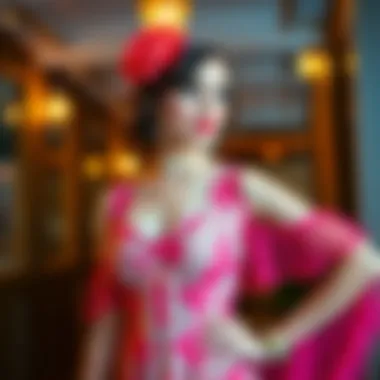

Intro
The 1920s swing dress represents more than just a piece of clothing; it serves as a symbol of freedom, rebellion, and a cultural shift in an era before the Second World War. With its flapper roots, this garment captures a transformative period in fashion history, directly influenced by the jazz scenes echoing through speakeasies and dance halls. Originating as a response to the restrictive garments of the previous decades, the swing dress embodies a spirit of liberation that many young women of the time craved.
The design of the swing dress features a loose, flowing silhouette that allowed girls to dance freely, embodying the exhilarating rhythms of jazz music and the liberating aura of the Roaring Twenties. This uniquely stylish garment not only defined a generation but also set the foundation for future fashion trends. For contemporary fashion influencers, understanding the significance and evolution of the swing dress can inform modern styling and inspire new collections.
In the following sections, we will explore the fashion trends that the swing dress popularized, examine its timeless nature, and how it remains relevant in today's fast-changing fashion environment. Furthermore, we will provide insight into how stylists and designers can make this iconic piece work in present-day wardrobes.
Historical Overview of the 1920s Swing Dress
The 1920s swing dress stands out as a hallmark of fashion history, representing not only a style but an entire cultural movement. This attire became synonymous with the exuberance of the Jazz Age, a time when societal norms shifted dramatically due to changes in economics, politics, and art. The swing dress served as a visual representation of newfound freedoms, particularly for women, juggling between elegance and comfort. The importance of understanding its historical context lies not only in appreciating the fashion statement it made but also in recognizing the socio-political currents that shaped its emergence.
The Emergence of the 1920s Fashion Scene
As the dust settled after World War I, the world entered a period ripe with innovation and bold ideas. The 1920s fashion scene burgeoned, spurred on by the invention of new textiles and manufacturing techniques. Following years of wartime austerity, styles shifted dramatically. Women began seeking freedom in both dress and life. Enter the swing dress: a creation that encapsulated this desire for liberation and joy. The loose, flowing lines allowed women to move freely, a stark contrast to the corseted looks of the previous century. Ladies donned these dresses while dancing to the rhythm of jazz music in speakeasies and social gatherings, evidence of a culture vibrating with life and enthusiasm.
Symbolism of the Swing Dress
The swing dress symbolized the shifting paradigms of femininity in the 1920s. It wasn't merely a dress; it was a statement. It signified rebellion against traditional feminine constraints, allowing wearers to embrace a more liberated identity. Women wore these dresses to express their participation in the flapper movement, showcasing their independence. The swing dress, typically adorned with beads and fringe, echoed the jazz-infused ambiance of the era. Something about its design invited movement; it became a visual representation of a new woman. A woman who dances, laughs, and enjoys life on her terms.
“Fashion is about something that comes from within you.” – Ralph Lauren
Influences from Jazz and Dance Culture
The pervasive influence of jazz music and the dance culture placed the swing dress at the center of a vibrant social scene. The popularization of jazz led to the creation of new social spaces where women could express themselves fully. The Charleston and Lindy Hop, characterized by energetic rhythm and carefree moves, demanded a new kind of apparel. Traditional outfits simply didn't cut it anymore; hence the swing dress, with its emphasis on comfort, was birthed. Styles flourished as dancers required attire that allowed them to spin and twirl with ease. Jazz wasn’t just music—it was a movement that encouraged self-expression, and the swing dress became an essential element of that dynamic.
Design Characteristics
The design characteristics of the 1920s swing dress are fundamental in understanding its lasting appeal and significance in fashion history. Detailed attention to silhouettes, fabrics, graphics, and colors collectively underscores why this garment remains a revered staple in modern wardrobes.
Silhouettes and Cuts
When one speaks of the silhouettes and cuts inherent to the swing dress, it is essential to highlight the defining A-line shape. This silhouette, characterized by its fitted bodice and flaring skirt, creates an illusion of movement and freedom which resonated deeply with the women of the Jazz Age. The cut often fell just below the knee, allowing for ease of movement and a playful swish, ideal for dancing the Charleston or Lindy Hop.
Beyond just aesthetics, the swing dress was a release from the constrictive fashions of earlier decades. It mirrored a societal shift towards modernity and self-expression. Elegant draping techniques and additional design elements such as dropped waists were not merely trends; they represented a burgeoning liberation for women. It was all about comfort and style, with a slight rebellion woven into the very fabric of the dress.
Fabrics and Textures
The choice of fabrics used in the 1920s swing dress plays a crucial role in achieving both elegance and comfort. Common materials included lightweight cotton, silk, and rayon, each possessing distinct qualities. For instance, silk provided a luxurious sheen, while cotton offered breathability, suitable for warmer weather events. The use of rayon also revolutionized dressmaking, as it was a more affordable alternative to silk, ensuring that the beauty of the swing dress was accessible to a wider audience.
Textural elements often came into play through the integration of lace, embroidery or layering. These formats not only enriched visual interest but also added depth to the wearer’s overall aesthetic. Fabrics were chosen not just for their look, but for the way they blended fluidity with form, ensuring that every twist and turn made a statement.
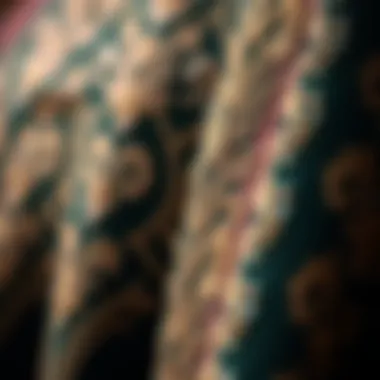
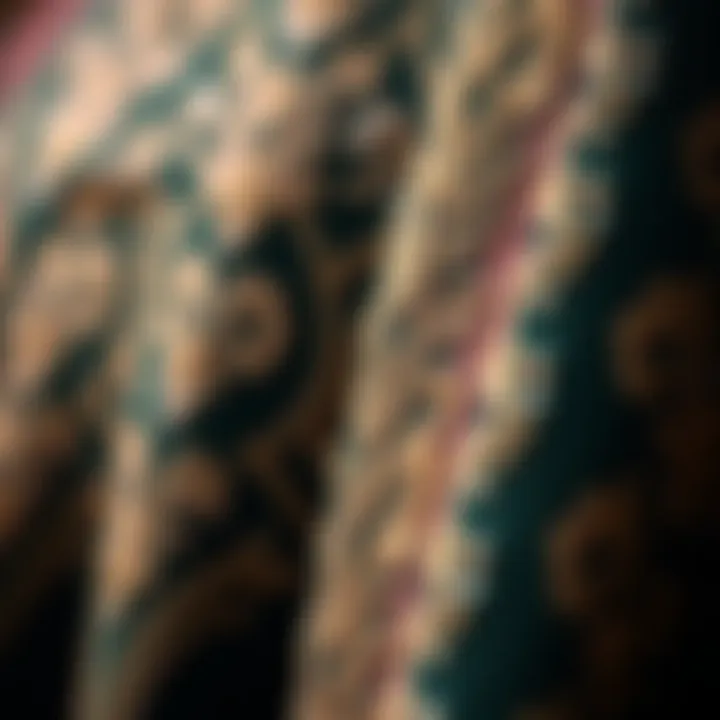
Graphics and Patterns
Graphic patterns on swing dresses varied widely, encapsulating the spirit of creativity that defined the 1920s. Bold geometric shapes, artistic florals, and sometimes even abstract prints became popular. Each design choice conveyed a narrative unique to the wearer. The art deco influence is especially notable, with its emphasis on symmetry and stylized motifs. This visual language celebrated modernity, reflecting the societal leaps of the era.
Additionally, patterns often served a garment’s function, like stripes that accentuated the dress's flow or polka dots which evoked a playful charm. The patterns became a silent language through which women could express their individuality, aligning with the burgeoning personal freedom of the decade.
Colors and Their Meaning
In the 1920s, color theory played a significant role in fashion, with every hue conveying distinct meanings or emotions. For instance, vibrant colors like red and royal blue symbolized boldness and confidence, while softer pastels were seen as symbols of femininity and grace. Black and white provided versatility and were often staples in evening wear, exuding elegance and sophistication.
Moreover, the combination of colors sparked a sense of excitement about the new opportunities life had to offer. This was a time when bright colors mirrored the zest of the Jazz Age culture, where vibrant celebrations and nightlife reigned supreme. When donning a swing dress, women were not just wearing clothing but were embodying the very spirit of modernity.
"The swing dress is not just a fashion statement; it is an emblem of a transformative era for women, weaving together threads of liberty and creativity."
By examining the design characteristics of the 1920s swing dress, one can appreciate the craftsmanship behind this garment. From the flattering silhouettes and textures to the symbolic colors and graphics, each element played its part in a dress that encapsulated the vibrant essence of the Roaring Twenties.
Cultural Impact
The cultural impact of the 1920s swing dress runs deeper than mere fabric and thread; it encapsulates a chapter of history marked by transformation, rebellion, and creative vigor. The swing dress emerged against the backdrop of a post-World War I society yearning for change. Women were stepping into new roles, embracing independence, and challenging age-old norms. In this light, the significance of the swing dress transcends aesthetics to embody a spirit of newfound freedom and self-expression. This section discusses the key elements that truly highlight how this dress shaped not only fashion but societal perceptions and roles.
The Flapper Movement
The flapper movement was a direct response to the constraints women faced in the late 19th and early 20th centuries. Characterized by shorter hemlines, bobbed hair, and bold makeup, flappers used the swing dress as a canvas to express their defiance against traditional expectations. The swing dress itself—with its loose fit and flared hem—allowed women to move with ease, characteristics that stood in stark contrast to the more conservative styles of previous generations.
Notably, the iconic flapper silhouette had roots in a longer line of dresses but morphed into a playful, liberating garment. It was not just about aesthetics; for many women, wearing a swing dress felt like donning a badge of modernity. As flappers danced their hearts out in jazz clubs, the dress became synonymous with the jazz age. Women were making a statement: they were not only players in the societal game but were altering the rules altogether.
The Role of Women in Fashion
The role of women in fashion during the 1920s marked a significant turning point. The swing dress served as a pivotal medium through which women expressed their social status and aspirations. It is vital to recognize that clothing became a form of political expression; women were no longer merely dressing to please others but were showcasing their identity. The evolution of the swing dress paralleled women's growing rights to vote and work.
As women entered the workforce in greater numbers and participated in social and political movements, the swing dress evolved alongside them. Designers like Coco Chanel simplified the silhouette, favoring comfort and functionality. Women began choosing outfits that highlighted style and independence. The swing dress became more than a mere clothing item; it transformed into a symbol of empowerment—amplifying women’s voices in both fashion and societal spheres.
Impact of Cinema and Celebrities
The roaring twenties also gave rise to the silver screen, where stars commanded influence over fashion choices. Women looked to actresses like Clara Bow and Louise Brooks, who not only wore swing dresses but embodied the flapper spirit. The portrayal of these women in films reached audiences far and wide, making their style choices desirable and aspirational.
With the rise of Hollywood, the swing dress achieved mainstream popularity, as moviegoers emulated the on-screen styles they admired. Celebrities also played a crucial role in the dissemination of the dress through red carpet appearances and social engagements. Thus, the swing dress became entrenched in the collective imagination, evolving beyond mere fabric into an emblem of glamour and stylish rebellion.
"Fashion not only reflects society but shapes it; just as the swing dress did for women of the 1920s."
Modern Interpretations
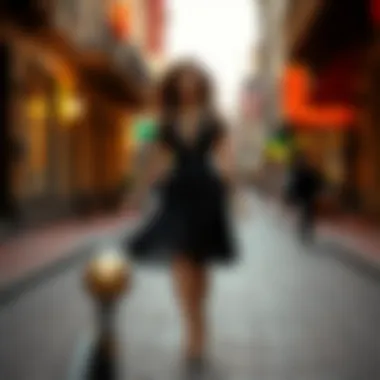

The journey of the swing dress does not end with its historical significance. Instead, it continues to thrive within contemporary fashion, adapting and evolving to meet modern sensibilities. This section shines a spotlight on how designers and consumers weave the spirit of the 1920s into today's wardrobe. Understanding these modern interpretations is crucial for fashion influencers, stylists, and marketers as they navigate the intricate dance of maintaining the dress's legacy while appealing to a contemporary audience.
Contemporary Fashion Designers
A slew of designers have embraced the swing dress, giving it a fresh twist while respecting its roots. Brands like Sandro Ferrone and ModCloth have introduced swing dresses that mix today’s fabrics and cuts with the classic flair of the 1920s. These designers select bold prints and vibrant colors, sometimes layering in modern details like asymmetrical hems or unique fabric blends to attract a younger crowd.
Additionally, high-profile names such as Diane von Furstenberg have taken cues from the timeless swing silhouette, introducing pieces that encourage movement and expression, fundamental characteristics of the original design. By opting for lightweight materials, these designers offer a nod to the functionality that the swing dress embodied, perfect for parties or afternoon outings.
"Fashion is more than just clothing. It’s a revival of emotions and stories threaded through fabric."
— Fashion Designer
The Swing Dress in Modern Wardrobes
In today’s society, the swing dress is more than a relic. It serves as a staple piece that seamlessly transitions from day to night. Casual outings, brunches, or even formal gatherings—this dress holds its ground, offering versatility like no other. Often worn with sneakers or ankle boots in the daytime, it can be easily elevated with a chic pair of heels and statement jewelry for evening events.
Wardrobe Tip: Consider incorporating different layering techniques. A fitted jacket can redefine this classic garment, while a long cardigan evokes a more laid-back vibe.
Here are a few styling ideas for the modern swing dress:
- Pair with a denim jacket for a relaxed look.
- Add a wide-brim hat and chunky necklace for an artsy flair.
- Incorporate sheer tights and boots for cooler seasons.
This adaptability helps the swing dress maintain its appeal across various seasons and demographics, making it popular among fashion vlogs and social media influencers aiming to inspire their followers with timeless, yet trendy outfits.
Sustainable Fashion Trends
Sustainability continues to be a driving force in fashion, and the swing dress finds itself at the intersection of style and conscientious consumerism. Many modern designers are now opting for eco-friendly fabrics, such as organic cotton and Tencel, aligning the beauty of this dress with the importance of ethical fashion. By championing recycled materials, brands aim to reduce the carbon footprint traditionally associated with the fashion industry.
As consumers become more aware of their purchasing choices, the swing dress has evolved into a symbol of sustainable fashion—a piece that reflects both style and social responsibility. Emphasizing timelessness over fast fashion, many modern interpretations come with an emphasis on quality, durability, and longevity, encouraging wearers to invest in fewer, better garments. This conscious shift has resonated particularly well with younger generations who prioritize sustainability in their fashion choices.
To fully embrace the modern swing dress, one need only explore how these influences converge. From the designers revitalizing it in their collections to the conscious consumers making sustainable choices, the dress not only embodies the spirit of freedom from the 1920s but also reclaims its place in a more conscientious fashion landscape.
Styling the Swing Dress
Styling the swing dress is more than just choosing an outfit; it's about embracing a cultural moment that shaped fashion history. The 1920s swing dress, with its effortless movement and playful design, embodies the spirit of flapper culture and the jazz age. For fashion influencers, stylists, and designers, understanding how to style this garment can effectively guide wardrobe choices, both contemporary and classic.
When considering how to showcase a swing dress, it's vital to think about how individual elements come together to create a cohesive look. This may include accessories that elevate the outfit, selecting proper footwear, and applying seasonal considerations that enhance versatility.
Accessorizing the Look
Accessorizing can be an art form, and the swing dress provides a beautiful canvas. When picking accessories, think of statement pieces that catch the eye without overwhelming the dress. Long strands of pearls or chandelier earrings bring a touch of 1920s glamour. Wide-brimmed hats can exude sophistication while also providing a retro vibe.
Here are some points to consider:
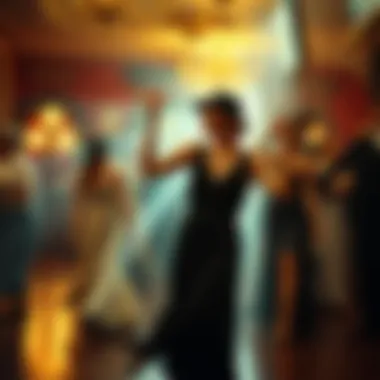

- Bags: A small clutch or a beaded handbag can complement the swing dress perfectly, echoing the elegance of the era.
- Jewelry: Opt for pieces that reflect the geometric designs and styles popular in the 1920s. Think Art Deco motifs.
- Scarves: A silk scarf tied around the neck adds flair and can be adjusted with the weather or event.
- Belts: Adding a belt, particularly one with embellishments, can define the waist and enhance the silhouette.
Incorporating these accessories creates a polished look that bridges the past and the present.
Footwear Choices
The right shoes can either make or break an outfit. For the swing dress, comfort is just as important as style. The 1920s were known for the rise of the Mary Jane and T-strap shoes, and these styles still shine today. They pair beautifully with the swing dress, allowing for free movement while dancing or walking.
Consider these footwear options:
- Flats: Comfortable and chic, perfect for a relaxed day out.
- Heels: A moderate heel, like a chunky block heel, retains style without sacrificing comfort.
- Boots: In cooler months, ankle boots can create a fun contrast with a swing dress, adding an edge that diverges from traditional looks.
All in all, the footwear should suit the occasion while providing some versatility as well.
Seasonal Styling Tips
Adapting a swing dress to different seasons can showcase its versatility. During the warmer months, lightweight fabrics can help keep things breathable, while layering techniques can extend its wear into cooler weather.
Here are some strategies for seasonal adaptations:
- Spring/Summer: Keep it light. Opt for floral patterns and shorter hemlines. Pair with sandals or wedges.
- Fall: Layer with a trench coat or a tailored blazer. Emphasize colors like mustard or burnt orange. Pair with ankle boots for warmth.
- Winter: Combine with thick tights and a cozy cardigan. Choose deeper colors or rich textures to reflect the season.
- Layering: Don’t shy away from creatively mixing and matching. A fitted turtleneck beneath a swing dress adds warmth and a unique flair without losing the original design's spirit.
The swing dress remains a versatile piece through the whims of fashion and seasons, delighting women with its timeless appeal.
By mastering the art of styling the swing dress, fashion influencers and enthusiasts alike can honor a legacy while forging their unique paths in modern fashion. Whether for casual outings or elegant soirées, the swing dress can truly shine with the right touch.
Future of the Swing Dress
The future of the swing dress holds intriguing prospects as it continues to find its place in the contemporary fashion lexicon. The allure of this garment lies not just in its historical significance, but also in its adaptability to changing trends. A number of factors contribute to the ongoing relevance of the swing dress, from evolving cultural attitudes towards body image to the rise of sustainable fashion. This section explores how the swing dress may evolve in a world that is constantly shifting in style and values, examining specific elements that enhance its future potential.
Evolving Trends
Fashion is a fickle mistress, and trends come and go, but the swing dress has a knack for standing the test of time. New iterations of this classic silhouette crop up every couple of seasons. Designers often play with length, proportion, and embellishments to breathe fresh life into the swing dress.
- Length Adjustments: Modified hemlines, whether tea-length or mini, keep the swing dress current.
- Material Choices: Advances in fabric technology have led to innovative textiles that offer not only comfort but also distinct visual appeal. Imagine a swing dress rendered in eco-friendly materials, merging nostalgia with modern sustainability.
- Inclusivity in Design: The body positivity movement has prompted designers to produce swing dresses that cater to various body shapes and sizes. There’s a growing appreciation for styles that celebrate diversity, making the dress more appealing to a broader audience.
Adapting these elements while holding onto the dress's original charm can ensure its longevity as a fashion staple. Newer generations might see the swing dress not just as a relic of the past, but as a versatile garment suited for today's fashion landscape.
Legacy and Enduring Appeal
There’s something about the swing dress that whispers tales of freedom and rebellion. While modern iterations carry the signature swing shape, they also evoke feelings of nostalgia, reminding wearers of the spirit of the Jazz Age. Its legacy lies intertwined with significant social movements, and this connection only enhances its allure.
"The swing dress, with its free-flowing design, captures the essence of self-expression that the 1920s championed."
- Cultural Resonance: The enduring chart of its popularity reflects societal changes. Today, many wear it to commemorate an era that allowed women to express themselves freely, merging grace with style.
- Redefining the Aesthetic: Fashion influencers on platforms like Instagram and Pinterest share their unique takes on the swing dress, crafting looks that are fresh and innovative. From pairing it with combat boots to layering it with oversized jackets, the ways to style this dress keep multiplying.
- Timeless Versatility: The swing dress isn’t just reserved for fancy soirées or themed parties. With the right combinations, it can seamlessly transition from professional to casual environments, appealing to working women and fashion enthusiasts alike.
The depths of the swing dress's past not merely inform its present but also shape its future. Its ability to reinvent itself while maintaining core characteristics is what keeps the conversation around it alive. As culture shifts, expect the swing dress to embody a nuanced understanding of femininity, elegance, and history, continuing to charm those who dare to wear it.







